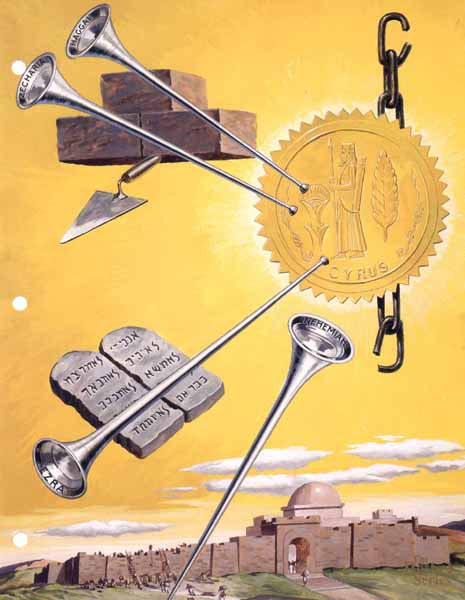Thus says Cyrus, King of Persia:
"The Lord of God of heaven, has given me all the kingdoms of the earth, and he has charged me to build him a house at Jerusalem, which is in Judah. Whoever is among you of all his people, may his God be with him, and let him go up to Jerusalem, which is in Judah, and rebuild the house of the Lord, the God of Israel -- he is the God who is in Jerusalem; and let each survivor, in whatever place he sojourns, be assisted by the men of his place with silver and gold, with goods and with beasts, besides freewill offerings for the house of God which is in Jerusalem." Ezra 1:2-4
This edict, issued by Cyrus, conqueror of Babylon, broke the chains of a captive people. Judah was free and an exodus to the homeland began. The return was led by Shesh-bazzar, sone of Jehoiachin. Laden with treasures, this Judean prince and a company of designated leaders led thousands of freedom hungry people back to their homeland.
- Reconstruction of the Temple Begins - Seven months after their return, the kingdom builders, under the leadership of Jeshua and Zerubbabel, took the first steps toward the reconstruction of the temple. A temporary alter was built, workers and materials were solicited, and in the second year the foundation of the temple was laid. The Samaritans (from Israel, the North), who occupied the Holy Land during the exile, were eager to participate in the building venture and requested to help build with the returning Jews but were refused. Enraged, the Samaritans began an organized effort to frustrate the Jews building plans. A letter to King Artaxerxes, one of Cyrus' successors, had its desired effect and the work on God's house was halted.
- Two Prophets Appear on the Scene - "Delay no longer, rebuild the temple NOW!" was the urgent message of Haggai and Zechariah. They were convinced that contemporary world events were a prelude to the coming Kingdom of God and called for rapid action and got it. The Samaritans persisted in their opposition but this time their efforts backfired. The new king Darius ordered them to cease resistance and then commanded them to bear a major part of the costs of the building. With the opposition eliminated, the work on the temple continued without further incident and was completed in 515 B.C.
- Reconstruction of the City Walls - The holy city without its walls was a disgrace to the Jewish people. Nehemiah, a cup bearer in the Persian king's court, asked permission to go back to Jerusalem to help rebuild the walls. His request was granted and he returned to the Holy City. He inspected the damage and led a reconstruction program which changed the face of Jerusalem. Sanballat, governor of Samaria, and Tobiah, governor of Ammon, planned a surprise attack on the builders but called it off when their treachery was discovered. Men continued their work with bricks in one hand and swords in the other. A second plot was devised but failed like the first. Fifty-two days after construction was started, the task was completed. The walls around the city stood again. Israel's new Jerusalem as prophesied by Ezekiel was emerging. The NEW ZION proclaimed by Isaiah was coming to pass.
- The Law Reform - When the temple cult and old sacrificial system had been reestablished under the leadership of Haggai and Zechariah, Ezra arrived with a law reform. Authorized by the Persian king to set up an autonomous legal community among the returned exiles, Ezra carried out the monarch's wishes to the last degree:
And Ezra the priest brought the law before the assembly, both men and women and all who could hear with understanding, . . . And he read from it facing the square before the Water Gate from early morning until midday . . . and the ears of all the people were attentive to the book of the law . . . And they read from the book, from the law of God, clearly; and they gave the sense, so that the people understood the reading.
For seven days the reading of God's Holy Law continued and a LAW COMMUNITY was born. The law was written in Hebrew and the new generation of Jews grew up learning Aramaic in Babylon. Not until 1948 was Hebrew again the official language of the Jews.
- Law Reform Leads to Renewed Emphasis Upon Separation - Ezra was convinced that Israel's darkest hours of its history had always been closely associated with its failure to remain a separated people. He was alarmed over the pagan assimilation which he saw growing in the new community. Ezra called for a new radical separatist policy. He insisted that all Jews that had taken foreign wives in the early years of the restoration divorce them. A second meeting was called and the command for separation was sounded again. The people yielded and the policy was carried out (Ezra prevented Judaism from passing into oblivion). The reformers saw separation as the answer to all their problems. Though these efforts to inaugurate a strict separatist policy were born out of a sincere desire to be obedient to God's will, these zealots soon forgot, as had their predecessors, the positive purposes inherent in separation. Hence, the period of Restoration fostered a conservative Judaism which lived to observe the letter of the law, but didn't recognize the spirit in which the law had been given.
|

